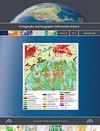Proxemic maps for immersive visualization
IF 2.4
3区 地球科学
Q1 GEOGRAPHY
Cartography and Geographic Information Science
Pub Date : 2022-01-24
DOI:10.1080/15230406.2021.2013946
引用次数: 10
Abstract
ABSTRACT In human computer interaction, proxemics describes the ways that people use space to interact with other people or objects. We focus on proxemic maps, which are virtual maps in immersive environments that react to proxemic interaction. Proxemic maps take advantage of new opportunities brought about by immersive visualization, where virtual maps can be freely positioned in virtual or physical space and adapt themselves relative to the spatial position of the viewer. We discuss proxemic interactions that alter the content and type of maps, including changing scale, symbolization, type of visualization and geometry. We propose a novel transformation that changes the geometry of maps based on their proximity to users. Users move the map back and forth and the map transitions between ring, horizontal, vertical and cylindrical geometries. The ring geometry surrounds the user and aligns features on the map with features in the real world. We implemented the map transformation in virtual reality and conducted a user study to evaluate it. The results of the user study indicate that participants preferred the ring and horizontal geometries. The ring geometry is useful because it simplifies connecting virtual features on the map with real features in the landscape, while the horizontal geometry provides an overall view of the landscape. We further found that combination of different geometries helped the study participants to overcome the limitations of each geometry.用于沉浸式可视化的邻近地图
在人机交互中,邻近学描述了人们利用空间与其他人或物体进行交互的方式。我们专注于邻域地图,这是沉浸式环境中的虚拟地图,可以对邻域互动做出反应。邻近地图利用了沉浸式可视化带来的新机遇,虚拟地图可以在虚拟或物理空间中自由定位,并根据观察者的空间位置进行调整。我们讨论了改变地图内容和类型的邻近相互作用,包括改变比例尺、符号、可视化类型和几何形状。我们提出了一种新颖的变换,根据地图与用户的接近程度来改变地图的几何形状。用户来回移动地图,地图在环形、水平、垂直和圆柱形几何图形之间转换。环形几何体围绕着用户,并将地图上的特征与现实世界中的特征对齐。我们在虚拟现实中实现了地图转换,并进行了用户研究来评估它。用户研究的结果表明,参与者更喜欢环形和水平几何形状。环形几何结构很有用,因为它简化了将地图上的虚拟特征与景观中的真实特征连接起来的过程,而水平几何结构则提供了景观的整体视图。我们进一步发现,不同几何形状的组合有助于研究参与者克服每种几何形状的局限性。
本文章由计算机程序翻译,如有差异,请以英文原文为准。
求助全文
约1分钟内获得全文
求助全文
来源期刊
CiteScore
5.20
自引率
20.00%
发文量
23
期刊介绍:
Cartography and Geographic Information Science (CaGIS) is the official publication of the Cartography and Geographic Information Society (CaGIS), a member organization of the American Congress on Surveying and Mapping (ACSM). The Cartography and Geographic Information Society supports research, education, and practices that improve the understanding, creation, analysis, and use of maps and geographic information. The society serves as a forum for the exchange of original concepts, techniques, approaches, and experiences by those who design, implement, and use geospatial technologies through the publication of authoritative articles and international papers.

 求助内容:
求助内容: 应助结果提醒方式:
应助结果提醒方式:


